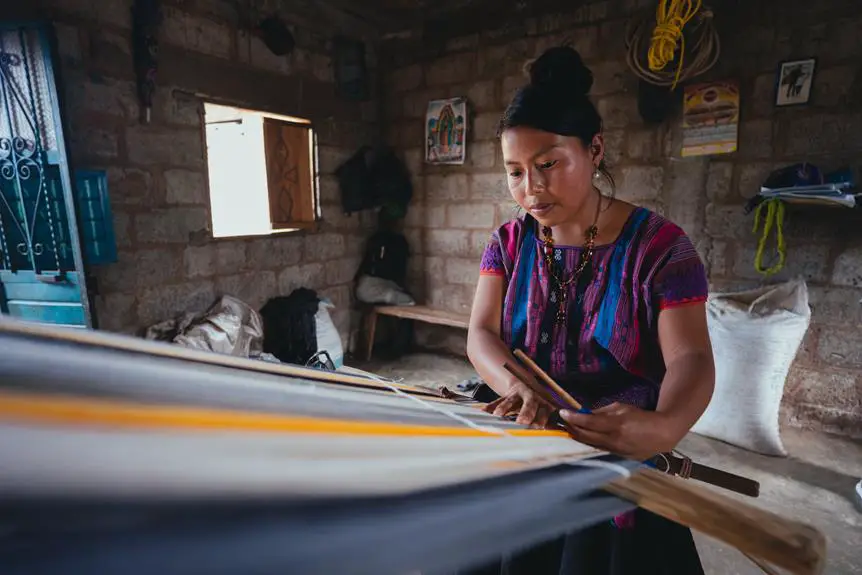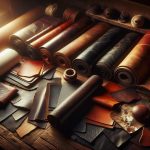Are you making the most of your ream of fabric?
As a crafting enthusiast, you may have discovered that a single piece of fabric holds endless creative possibilities. From choosing the perfect projects to understanding fabric grain and direction, mastering the art of fabric manipulation can elevate your crafting to new heights.
This guide is designed to help you unlock the full potential of your fabric stash, offering insights on maximizing efficiency, storage and organization, utilizing scraps creatively, and more.
Whether you're a seasoned seamstress or a novice quilter, these tips and techniques will empower you to make the most of every inch of fabric and take your crafting skills to the next level.
Key Takeaways
- Consider the type of project, weight, drape, stretch, and care instructions for the fabric
- Carefully plan pattern layout to minimize leftover scraps
- Align pattern pieces, explore alternative layouts, and strategically position pattern pieces to reduce waste
- Utilize fabric scraps for scrap quilting, upcycling projects, patchwork coasters, fabric buttons, and fabric bookmarks
Choosing the Right Fabric Projects
Are you struggling to choose the right fabric projects for your ream of fabric? With so many fabric project ideas out there, it can be overwhelming to decide where to start.
When it comes to selecting the right fabric for your projects, it's important to consider a few key tips to ensure your creations turn out just the way you envision.
First and foremost, think about the type of project you want to undertake. Whether it's a delicate dress, a sturdy tote bag, or a cozy quilt, each project will require a specific type of fabric to achieve the best results. Consider the weight, drape, and stretch of the fabric in relation to your project to ensure it will perform as intended.
Additionally, take into account the care instructions for the fabric. Some projects may require frequent washing, while others may need to withstand high heat or dry cleaning. Choosing a fabric that aligns with the care needs of your project will ensure longevity and practicality.
Lastly, don't be afraid to experiment with different fabrics for the same project. Swapping out one fabric for another can completely transform the look and feel of your creation, allowing for endless possibilities and creativity.
Maximizing Fabric Efficiency
Hey there!
When it comes to making the most out of your ream of fabric, maximizing efficiency is key.
Fabric layout tips, waste reduction techniques, and pattern matching strategies are all essential to ensure you're getting the most out of every inch of fabric.
Fabric Layout Tips
When laying out your fabric for a new project, it is important to consider maximizing efficiency to make the most of your ream of fabric. Efficient fabric cutting and handling can significantly impact the outcome of your project. Here are some fabric layout tips to help you maximize fabric efficiency:
| Fabric Cutting Tips | Fabric Handling Tips |
|---|---|
| 1. Plan your cuts carefully | 1. Smooth out the fabric before cutting |
| 2. Use pattern weights to hold the pattern in place | 2. Use sharp fabric scissors |
| 3. Cut single layers of fabric to ensure precision | 3. Handle delicate fabrics with care |
| 4. Consider using a rotary cutter for straight lines | 4. Use a cutting mat to protect your work surface |
| 5. Match plaids and stripes with precision | 5. Store fabric neatly to prevent wrinkles |
These tips will help you make the most of your fabric and achieve optimal results in your sewing projects.
Waste Reduction Techniques
To maximize fabric efficiency and reduce waste, consider implementing techniques that prioritize precise cutting and minimize unused fabric.
Embracing sustainable sewing practices can significantly reduce fabric waste while maximizing the use of your ream of fabric. One effective technique is to carefully plan your pattern layout to minimize leftover scraps. Take the time to arrange pattern pieces in a way that minimizes the amount of fabric needed for each cut.
Additionally, consider using fabric scraps for smaller projects or creating fabric strips for quilting or other crafts. Another approach is to explore pattern modifications that allow for efficient use of fabric, such as altering seam allowances or adjusting hem lengths.
Pattern Matching Strategies
Are you aiming to maximize fabric efficiency using pattern matching strategies?
Fabric matching and pattern selection are crucial for minimizing waste and getting the most out of your ream of fabric. When laying out pattern pieces, consider the fabric's design, such as stripes, plaids, or directional prints. Align pattern pieces to ensure the print continues seamlessly across seams, creating a polished and professional look.
Additionally, exploring alternative layouts or adjusting pattern placement can help optimize fabric usage. By strategically positioning pattern pieces, you can reduce fabric waste and maximize the yield from your fabric ream.
Thoughtful consideration of fabric matching and pattern selection not only enhances the aesthetic appeal of your projects but also demonstrates your mastery in maximizing fabric efficiency.
Storage and Organization Tips
Are you tired of struggling to find the right fabric when you need it?
Let's talk about some simple yet effective ways to keep your fabric collection organized and easily accessible.
From smart folding techniques to creative storage solutions, there are plenty of tips to help you make the most of your ream of fabric.
Fabric Folding Techniques
You can maximize your ream of fabric by using effective fabric folding techniques for storage and organization. Fabric folding hacks and space-saving techniques are essential for keeping your fabric collection neat and easily accessible.
One innovative fabric storage solution is to use clear plastic bins or drawers, allowing you to see the fabric designs and colors without having to rummage through piles.
Another DIY solution is to fold your fabric pieces into uniform sizes and stack them vertically, just like filing books on a shelf. This not only saves space but also prevents creases and wrinkles.
Creative Fabric Storage
Maximize the potential of your fabric ream by implementing creative storage and organization tips that will elevate the functionality and aesthetic appeal of your fabric collection.
Consider fabric hanging as a space-saving solution. Install a rod or use a hanger with clips to hang fabric pieces, ensuring easy access and visibility.
Fabric wrapping is another clever method. Utilize fabric bolts or cardboard tubes to neatly wrap and store your fabric, preventing creases and keeping it tidy.
Additionally, using clear plastic bins allows you to easily identify and access your fabric stash.
Implementing these fabric storage techniques not only maximizes space but also adds a visual appeal to your sewing or crafting area.
Labeling and Categorizing Fabric
Making the most of your ream of fabric starts with labeling and categorizing your collection for efficient storage and easy access. Proper fabric labeling not only helps you identify the type and quantity of fabric you have but also makes it easier to track fabric sourcing and pricing.
Consider labeling your fabric based on type, color, and pattern to streamline your categorization process. Utilize clear containers or shelves to categorize and store your fabric, ensuring that each type is easily accessible.
Utilizing Fabric Scraps Creatively
How can you creatively utilize fabric scraps to minimize waste and maximize your creative potential? Utilizing fabric scraps can be a rewarding way to reduce waste and create beautiful, unique projects. One popular method is through scrap quilting, where you can piece together different fabric scraps to form a stunning quilt. Additionally, upcycling projects offer a creative way to repurpose fabric scraps into new and useful items. Here's a table to inspire you with some innovative ideas for utilizing fabric scraps:
| Project | Description |
|---|---|
| Patchwork coasters | Create charming coasters by sewing together small |
| fabric scraps into patchwork designs. | |
| Fabric buttons | Make custom buttons by cutting out circles from fabric |
| scraps and attaching button backs. | |
| Fabric bookmarks | Cut fabric scraps into long strips and add a tassel or |
| embellishment to create personalized bookmarks. | |
| Quilted potholders | Sew together fabric scraps with insulating batting to |
| make durable and colorful quilted potholders. | |
| Fabric scrap garland | String together fabric scraps to make a colorful and |
| whimsical garland for decorating your space. |
Understanding Fabric Grain and Direction
To understand fabric grain and direction, evaluate the orientation of the fabric's threads and their impact on your sewing projects. Fabric grain refers to the direction of the threads in a woven fabric—lengthwise, crosswise, and bias. Understanding these elements is crucial for achieving professional-looking results in your sewing endeavors.
When working with fabric, it's important to be mindful of fabric stretching to prevent distortion in your projects. To prevent stretching, be sure to handle the fabric gently and avoid pulling or tugging excessively during the cutting and sewing process.
Additionally, controlling fabric shrinkage is essential for maintaining the integrity of your creations. To manage shrinkage, prewash and preshrink your fabric before starting your project. This helps to minimize unexpected shrinkage after your garment or item is completed.
Tips for Pattern Placement
When considering pattern placement on your fabric, it's important to take into account the fabric grain and direction to ensure optimal results in your sewing projects. To make the most of your ream of fabric, strategic pattern placement is crucial.
Firstly, pay attention to fabric cutting. Lay your pattern pieces out on the fabric, ensuring they're aligned with the grain line for a professional and polished finish. This is especially vital for patterns with distinct directional motifs or stripes.
Additionally, pattern scaling is key. Consider the size and spacing of the pattern on your fabric. Will the pattern be disrupted at the seams? Will certain parts of the design be cut off? Adjust the position of your pattern pieces to ensure a harmonious flow of the design across the finished garment. By doing so, you can avoid any mismatched patterns and achieve a cohesive look.
Fabric Care and Maintenance
To maintain your fabric's quality, regularly wash and store it according to the care instructions provided. When dealing with stains, it's essential to use the right stain removal techniques to avoid damaging the fabric. From gentle blotting for delicate fabrics to enzyme-based cleaners for tougher stains, understanding the appropriate method for each type of fabric is crucial. Additionally, preventing fabric shrinkage is vital, and this can be achieved by following proper washing and drying techniques. Furthermore, fabric dyeing methods can be used to refresh the color of your fabric or give it a new look. However, always ensure to follow the dyeing instructions to prevent any damage to the fabric. Lastly, fabric storage solutions are essential in preserving the quality of your fabric. Utilize acid-free tissue paper when folding and storing fabric to prevent creases and discoloration. Additionally, storing fabric in a cool, dark, and well-ventilated space can extend its lifespan.
| Fabric Care Tips | |
|---|---|
| Stain Removal Techniques | Fabric Storage Solutions |
| Fabric Dyeing Methods | Preventing Fabric Shrinkage |
Exploring Fabric Embellishments
Are you utilizing fabric embellishments to enhance your creations? Fabric embellishments can take your sewing projects to the next level, adding depth, texture, and visual interest.
Here are some techniques to help you explore fabric embellishments:
- Fabric Customization: Experiment with dyeing, painting, or printing on fabric to create unique patterns and designs. This allows you to personalize your fabric before even starting your project.
- Fabric Manipulation: Try techniques such as smocking, pleating, or quilting to manipulate the fabric's surface. This adds dimension and tactile appeal to your creations.
- Decorative Stitching: Use decorative stitches, embroidery, or appliqué to embellish your fabric. These techniques can add intricate details and vibrant colors to your projects.
- Trims and Accents: Incorporate trims like lace, ribbons, beads, or sequins to embellish hems, edges, or seams. These small additions can make a big impact on the overall look of your creation.
Frequently Asked Questions
Can I Use the Same Fabric for Both Clothing and Home Decor Projects?
You can use the same fabric for both clothing and home decor projects, as long as you consider the fabric's versatility and the limitations of each project. Consider the practicality in design and ensure the fabric suits both purposes.
What Are Some Creative Ways to Store Fabric in a Small Space?
To maximize your small space, consider fabric organization solutions like clear bins, hanging shoe organizers, or pegboards. Utilize multi-purpose fabric for both clothing and home decor projects, and get creative with fabric scrap projects or non-sewing uses for scraps.
How Can I Repurpose Fabric Scraps for Non-Sewing Projects?
Looking to repurpose fabric scraps? Get creative with DIY crafts and upcycling ideas. Try making fabric coasters, patchwork pillows, or fabric-covered storage boxes. With a little creativity, you can turn those scraps into something beautiful.
What Is the Difference Between Fabric Grain and Fabric Direction, and Why Does It Matter?
Understanding grainline and fabric direction is crucial for sewing techniques and fabric manipulation. The grainline follows the fabric's warp and weft threads, while fabric direction refers to the way the pattern runs. Mastery of these concepts enhances your sewing skills.
Are There Any Eco-Friendly Methods for Caring for and Maintaining Fabric?
To extend fabric longevity and care for the environment, consider eco-friendly cleaning methods such as cold water washes and air drying. Use gentle detergents and avoid harsh chemicals to maintain fabric quality.






